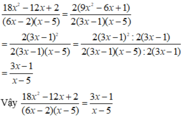Hãy nhập câu hỏi của bạn vào đây, nếu là tài khoản VIP, bạn sẽ được ưu tiên trả lời.

a ) \(\frac{4x+3}{x^2-5},A=12x2+9x\)
Suy ra \(\frac{4x+3}{x^2-5}=\frac{\left(4x+3\right).3x}{\left(x^2-5\right).3x}=\frac{12x^2+9x}{3x^3-15x}\)
Chúc bạn học tốt !!!

\(\dfrac{x-2}{x+2}\)
\(=\dfrac{\left(x-2\right)\left(x+2\right)}{\left(x+2\right)\left(x+2\right)}\)
\(=\dfrac{x^2-2^2}{\left(x+2\right)^2}\)
\(=\dfrac{x^2-4}{x^2+4x+4}\)
Vậy đã biến đổi phân thức thành một phân thức bằng nó và có tử bằng với đa thức: \(A=x^2-4\)

\(\dfrac{x^2-1}{\left(x+1\right)\left(x-3\right)}\)
\(=\dfrac{x^2-1^2}{\left(x+1\right)\left(x-3\right)}\)
\(=\dfrac{\left(x+1\right)\left(x-1\right)}{\left(x+1\right)\left(x-3\right)}\)
\(=\dfrac{x-1}{x-3}\)
Vậy đã biến đổi phân thức đó thành một phân thức bằng nó và có tử bằng với đa thức \(A=x-1\)

Bài 6:(Sbt/25) Dùng tính chất cơ bản của phân thức để biến đổi mỗi cặp phân thức sau thành một cặp phân thức bằng nó và có cùng tử thức :
a) \(\dfrac{3}{x+2}\)và\(\dfrac{x-1}{5x}\)
Ta có:
\(\dfrac{3}{x+2}\) = \(\dfrac{3.\left(x-1\right)}{\left(x+2\right)\left(x-1\right)}\) = \(\dfrac{3x-3}{x^2+x-2}\)
\(\dfrac{x-1}{5x}\) = \(\dfrac{\left(x-1\right).3}{5x.3}\) =\(\dfrac{3x-3}{15x}\)
Vậy .....
b. \(\dfrac{x+5}{4x}\) và \(\dfrac{x^2-25}{2x+3}\)
Ta có:
\(\dfrac{x+5}{4x}\) = \(\dfrac{\left(x+5\right)\left(x-5\right)}{4x.\left(x-5\right)}\) = \(\dfrac{x^2-25}{4x^2-20x}\)
\(\dfrac{x^2-25}{2x+3}\)
Vậy .....




A = 1 – 2x ⇒ 8 x 2 - 8 x + 2 : 1 - 2 x = 2 - 4 x
Suy ra: